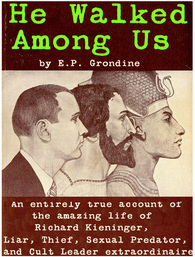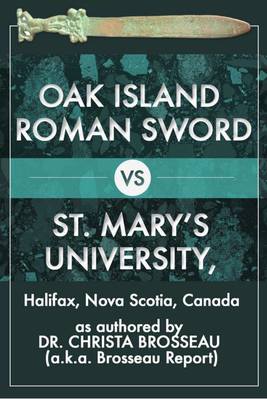Call me crazy, but I find writing and debugging computer code to be relaxing. It can be frustrating, of course, when you can't figure out the source of some problem or error, but overall the process of building and tuning a model is engaging and strangely soothing. The parts make sense, represent something, and work together. And there are rewards for elegant design. It's fun. During my dissertation work I sometimes had the luxury of taking full days (not 9-to-5 days, but 24 hour days) to focus on uninterrupted programming. Those days are gone, but I still find myself enjoying the times when I can block out a few hours, close my door, and get into the code.
The rest of the world doesn't stop, however. So I have a few things I wanted to briefly talk about today.

A reader of this blog emailed me some links to material that, for all I know, is familiar ground to those who closely watch "fringe" theorists. I had never heard of E. P. Grondine's manuscript He Walked Among Us, however, so I presume that others also have not. The work (available in three parts here), details the history, philosophy, and inter-personal interactions of "fringe" figures (including David Hatcher Childress) in a small town in northeastern Illinois. Thus far I have only skimmed through parts of it (it will go on my summer reading list). Check it out and see what you think.
I don't know E. P. Grondine and am not yet very familiar with his work. He has commented on this blog at least once.
I've succeeded in getting one of my models (ForagerNet3_Demography_V3) operational in Repast Simphony. Repast Simphony operates a little bit differently than Repast J (the platform that I used to write the model), so I had to learn something about those differences, write some new code, and re-configure some other sections of the code. Though I've still got some testing to do to make sure the model is behaving the same (i.e., it's doing the same thing it did before the conversion), everything seems to be working within the model itself.
The issue I'm trying to solve now is getting the model to run in batch mode. Running a model in batch mode means that the computer performs a series of model runs (a "batch") automatically. One of the great benefits of computational modeling is that you can do systematic experiments and determine cause and effect. You can hold everything about the model constant except for the value of single parameter, for example, and see how changes in that parameter affect the outcomes. You can run the model as many times as you want -- tens, hundreds, or thousands -- to flesh out those cause-effect relationships. Running the model in batch mode automates that process. Ideally, I can start a batch running on Friday afternoon and return to my office on Monday morning with a large dataset ready to analyze.
There is apparently a built in batch configuration in Repast Simphony, but for some reason I haven't yet been able to get to it in the software. Maybe I need to reinstall. For the time being, I've been using a simple little parameters file that just tells the software how many iterations of the model to perform and what random seed to use. The model runs for the first 40-50 runs before throwing an "Out of Memory" error and locking everything up. It seems to run slower and slower with each iteration, which suggests to me there is a memory leak somewhere in my code. The model creates a bunch of objects (people, households, social links between people) during each run. Each of those uses memory. At the end of each run, all the object associated with that run should be tossed out to free up all the memory for the next run (when the model resets and starts fresh). If some of the objects are "leaking through" and being retained in the memory, the progressive accumulation of those unused objects will eat more and more memory until there's none left. I'm pretty sure I've got the model tossing all the people, households, and links (the three agent classes) out, so it may have something to do with copies of the spatial world and/or what's called the "context." The structure of the "world" in Repast Simphony is different from that in Repast J, so I need to figure out how to make sure I'm getting rid of all the unused parts between each model run. That's my goal for today. Hopefully I can find and plug the memory leak and set my computer to work for me over the weekend.

I still haven't been able to muster the combination of time and interest to read through J. Hutton Pulitzer's "sword report." What I know about the contents of the report I know from comments on Facebook pages (e.g., The Fraudulent Archaeology Wall of Shame and Fake Hercules Swords), this blog post from last week, and Jason Colavito's post about the report. My two main impressions are these (please correct me if I'm wrong):
The report contains no new information about the alleged "Roman sword from Nova Scotia." Pulitzer does not provide his XRF data that he claimed proved the sword was a "100% confirmed" Roman artifact. He spent months crowing about his XRF results, and, in fact, said he would release them "the next day" after Brosseau's results were aired on television. He has not done that. Why? Remember when he said the exposed brass on the sword was actually gold? Whatever happened to that claim?
The report is an argument against Brosseau's interpretations, not her results. Pulitzer seems to have abandoned the argument that his XRF results are correct and Brosseau's results are wrong, and is arguing that the metals identified by Brosseau are consistent with those produced by Romans. He actually made this pivot some time ago (I wrote about it back in January). Sometime after Brosseau's results were aired, he decided that he had a better chance making a case for the antiquity of the sword based on Brosseau's results (which are well-explained and documented) than his own (let us never speak of those XRF results again?). Apparently, the "case" for the Roman antiquity of brass with 35% zinc is based on the same sleight-of-hand he tried in January (see this post) with the added puffery of 70+ pages lifted more-or-less directly from this online study by David Dungworth. Here is a direct quote from that study:
No matter how many times you assert that the sword is Roman, and no matter how long of a document you put together, evidence still matters. I still see no evidence that this is a Roman sword. I see continued monkey business, sleight of hand, and silliness. Can we move on to the next "smoking gun that will re-write history" now please? The sword is boring.
The Walking Dead is my favorite television show. The program has had its ups and downs, but I think this season is pretty strong and I'm enjoying it. I'm a couple of episodes behind right now, so don't spoil it for me.
This week, Disney and Marvel warned Georgia Governor Nathan Deal that they will stop filming in the state if he signs a so-called "religious liberty" bill that many say will legalize anti-gay discrimination (here's the story in The Washington Post).
I applaud Disney and Marvel for their stance, and hope that AMC follows suit and moves the filming of The Walking Dead out of northern Georgia. Given what's going on in North Carolina right now, the logical choice is to put the show in South Carolina. There are signs this state is moving in the right direction (e.g., the removal of the Confederate flag last summer), and your business would be a nice encouragement. Having traveled up and down I-20 and 301 a few times now, I can tell you that you won't have any difficulty finding good locations for filming. You can enjoy the palmettos, azaleas, crepe myrtle, and Carolina wrens. We have some room at our house, so I can provide accommodations for at least two cast members (Glen and Maggie? Carol?).
Just think it over. You don't have to answer now. If you can't make it here this spring the flowers will still be blooming all year round. And there are butterflies.


 RSS Feed
RSS Feed
